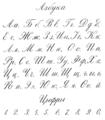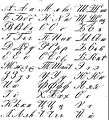Russian cursive

The Russian cursive ((ру́сское) рукопи́сное письмо́, "(Russian) handwriting script"[n 1]) is the handwritten form of the modern Russian Cyrillic script, used instead of the block letters seen in printed material. In addition, Russian italics for the lowercase letters are often based on the Russian cursive (such as lowercase т, which looks like Latin m). Most handwritten Russian, especially personal letters and schoolwork, uses the cursive alphabet. In Russian schools most children are taught from first grade how to write with this script.
History
_No.1736_20_december_1699.jpg)
The Russian (and Cyrillic in general) cursive has been developed during the 18th centuries on the base of the earlier Cyrillic tachygraphic writing (ско́ропись, "rapid or running script"[1]) which in turn was the 14th–17th chancery hand of the earlier Cyrillic bookhand scripts (called ustav and poluustav). It became the handwritten counterpart of so-called "civil" (or Petrine) printed script of books. In order, modern Cyrillic italic typefaces are based (in their lowercase part) mostly on the cursive shape of the letters.
The resulting cursive bears many similarities with the Latin cursive.[2] For example, the modern Russian cursive letters "АВДЕИКМНОРСУХ авдезиопрстухч" may coincide with Latin cursive "ABDEUKMHOPCYX abɡezuonpcmyxr" (𝒜ℬ𝒟ℰ𝒰𝒦ℳℋ𝒪𝒫𝒞𝒴𝒳 𝒶𝒷ℊℯ𝓏𝓊ℯ𝓃𝓅𝒸𝓂𝓎𝓍𝓇), respectively (despite having completely different sound values in many cases); both upright and italic printed typefaces demonstrate less similarity.
One must not confuse the historical Russian chancery hand (ско́ропись), the contemporary Russian cursive (рукопи́сное письмо́) and the contemporary Russian stenography. The latter is completely different from the other two, though it is sometimes called ско́ропись like the former.
Features

Russian cursive is much like contemporary calligraphic Latin cursive (including the English one). But unlike English handwriting, where many people tend to write routinely with letters which heavily resemble printed typefaces and use the running calligraphic cursive only occasionally, it is a standard practice to write Russian in Russian cursive almost exclusively.
There exists some ambiguity from the fact that several lowercase cursive letters consist (entirely or in part) of the element that is identical to the dotless Latin cursive letter ı, the cursive Greek letter ι or a half of the cursive letter u, namely и, л, м, ш, щ, ы. Therefore, certain combinations of these Russian letters cannot be unambiguously deciphered without knowing the language or without a broader context. For example, in the words волшебник, "magician" and домик, "little house" the combinations лш and ми are written identically. There are examples of different words that become absolutely identical in their cursive form, e.g. мщу, "(I) revenge" and лицу, "(to) a face".
In some forms of cursive the distinction between т and ш may become elusive, because both are written in the shapes of either m or ɯ. To alleviate this case of ambiguity, a horizontal bar can be written above the character (like m̅ or rarely ɯ̅) if it is т, or below (like ɯ̲ or rarely m̲) if it is ш. Also, writing т in its printed form (the T shape) rather than its usual m shape is common.
The letter д may also be written in the shape of ∂.
Several letters in Russian cursive are different from the cursive used in the Serbian and Macedonian languages. Thus, Serbian/Macedonian г and п are written like the cursive Latin i and u with macron (ī and ū) and the letter т is written in the shape of ɯ̅.
Charts
-

The standard modern Russian Cyrillic cursive alphabet with uppercase and lowercase letters, used in school education.
-

Russian calligraphic handwriting from a Russian schoolbook (1916).
-

19th century variants of Russian calligraphic cursive letters.
See also
Notes
- ↑ A printed variant of the Russian cursive (when it is reproduced in ABC books and other places) is typically referred to as (ру́сский) рукопи́сный шрифт, "(Russian) handwritten font".
References
- ↑
В XVIII веке скорописное письмо постепенно переходит в курсив.
≈ "During the 18th century, [Russian] tachygraphy gradually transitioned into cursive." - ↑
Термины «скоропись» и «курсив» в русской палеографии применяются параллельно, в то же время, в развитии русской скорописи намечаются тенденции, позволяющие выделить новый тип письма, схожий с латинским курсивным письмом, близким к современному. Если в частной сфере применения и в каллиграфии быстрее произошел переход к использованию курсивного письма, то в делопроизводственной традиции эти типы письма довольно долго сосуществовали.
≈ "Terms 'tachygraphy' and 'cursive' coexist in the Russian palaeography; meanwhile, in the development of the Russian tachygraphy there are tendencies that allow us to separate a new type of writing, one closer to the Latin cursive similar to its modern form. In the private sphere and in calligraphy, transition to the cursive writing occurred faster, but in the tradition of record keeping, these types of writing coexisted for a long time.— Белоконь, Е. А. (2001). "Характеристика почерков XVIII-XIX вв. и термины в описаниях собраний рукописей". Вспомогательные исторические дисциплины: специальные функции и гуманитарные перспективы ; тезисы докладов и сообщений XIII научной конференции. Moscow.
External links
Russian cursive writing practice sheet PDF
